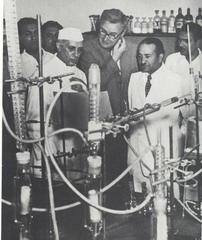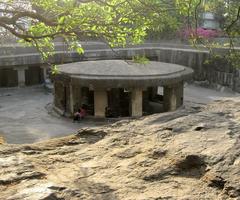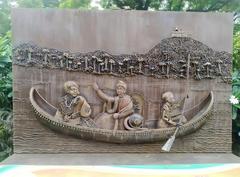
National Defence Academy Pune: Visiting Hours, Tickets, and Historical Significance
Date: 03/07/2025
Introduction
The National Defence Academy (NDA) in Pune, Maharashtra, stands as India’s foremost joint services training institution, molding future leaders of the Army, Navy, and Air Force. Established in the early 1950s and set amidst the scenic Sahyadri hills near Khadakwasla Lake, the NDA is not just a military academy—it is an emblem of India’s defense heritage and an architectural landmark. The academy is renowned for its rigorous three-year training program, blending academic excellence with comprehensive physical and military education (Free Press Journal, Wikipedia, Trawell.in).
Access to the NDA is highly regulated due to its strategic importance. Visitors require prior permission, and all visits must adhere strictly to security protocols. This comprehensive guide provides up-to-date information on NDA visiting hours, ticketing procedures, campus highlights, accessibility, and nearby attractions, helping you plan a respectful and enriching experience.
Table of Contents
- Introduction
- History and Foundation
- Architectural and Institutional Legacy
- Training and Curriculum Evolution
- Major Milestones and Achievements
- Social and Cultural Impact
- Visiting Hours, Tickets, and Guidelines
- Campus Highlights
- Accessibility and Visitor Facilities
- Nearby Historical Sites in Pune
- Practical Travel Tips
- Frequently Asked Questions (FAQs)
- Conclusion
- References
History and Foundation
The NDA’s genesis lies in the aftermath of World War II, when the need for joint training of India’s armed forces became clear. Recommendations in 1946 led to the creation of the Inter-Services Wing at Dehradun. The search for a permanent location culminated in the selection of Khadakwasla, with the Bombay State donating over 8,000 acres for the campus. The foundation stone, laid by Prime Minister Nehru on October 6, 1949, symbolized a new era in Indian defense education (Wikipedia, Free Press Journal). The NDA was officially inaugurated at Khadakwasla on January 16, 1955 (My Pune Pulse).
Architectural and Institutional Legacy
Spanning over 7,000 acres, the NDA campus is a blend of colonial and Indian architectural influences. Notable structures include:
- Sudan Block: A grand administrative building with red sandstone arches and a dome, constructed as a war memorial with Sudanese government funding.
- Hut of Remembrance: A solemn tribute to NDA alumni who sacrificed their lives for the nation.
- Ashoka Pillar: A 30-foot monument inspired by the Sarnath pillar, symbolizing unity and heritage.
- NDA Museum: Housing a rich collection of military memorabilia and artifacts (Trawell.in), (My Pune Pulse).
State-of-the-art training facilities include Olympic-size swimming pools, sports fields, a riding and polo ground, and technologically advanced classrooms and simulators (Wikipedia, DefenceGuru).
Training and Curriculum Evolution
NDA cadets undergo a three-year, six-term program that balances academics and military training. The curriculum offers undergraduate degrees in science, arts, and technology, recognized by Jawaharlal Nehru University (JNU) and the All India Council for Technical Education (AICTE) (Shiksha). Training is organized into Army, Naval, Air Force, and Joint Training Teams, fostering inter-service camaraderie and unity (SSBCrack). Cadets engage in rigorous physical conditioning, leadership exercises, equestrian and watermanship training, and advanced combat simulations (DefenceGuru).
Major Milestones and Achievements
In 75 years, the NDA has produced over 42,000 officers for India and friendly foreign nations (Free Press Journal). Its alumni have led all three services, represented India in UN missions, and earned the nation’s highest gallantry awards. Notably, in 2025, the NDA celebrated the historic graduation of its first batch of women cadets—a milestone of inclusivity and modernization (The Week).
Social and Cultural Impact
The NDA has played a pivotal role in shaping Indian military ethos and national identity. Ceremonies like the Passing Out Parade and traditions such as the Wreath Laying at the Hut of Remembrance embody the values of honor, duty, and sacrifice (Holidify). The admission of women cadets marks a significant cultural shift, reflecting evolving societal norms and the academy’s commitment to equality.
Visiting Hours, Tickets, and Guidelines
Visiting Hours:
- NDA is open to visitors only on Sundays, from 10:00 AM to 12:30 PM.
- Visits are strictly by prior written permission; casual walk-ins are not allowed.
Entry/Tickets:
- No entry fee is charged, but prior permission (at least 48 hours in advance) is mandatory, obtained by contacting NDA headquarters (Shiksha).
- Permission is typically granted to organized groups from educational institutions; individual and foreign tourist access is rarely approved.
Security:
- All visitors and vehicles are subject to thorough checks.
- Photography is restricted to specific areas and may be prohibited in sensitive locations.
- Visitors must bring government-issued photo IDs and adhere to the NDA’s strict dress code (formal or semi-formal attire; uniforms for students preferred).
Application Process:
- Submit group details, proposed date, ID proof, and vehicle information via post or email ([email protected]).
- Applications lacking complete information may be rejected.
Campus Highlights
- Sudan Block: Architectural centerpiece and administrative hub.
- NDA Museum: Historical memorabilia and artifacts.
- War Memorial: Honors fallen NDA alumni.
- Cadets’ Mess: Among Asia’s largest, accommodating over 2,100 cadets.
- Training Grounds: Parade and sports fields, including the Khetarpal Parade Ground (site of the Passing Out Parade).
- Weapon Technology Park: Showcases military hardware.
- Ashoka Pillar: National symbol and photo spot.
Note: Access to some areas may vary based on operational requirements.
Accessibility and Visitor Facilities
- Mobility: The vast campus involves significant walking; visitors with mobility issues should notify NDA officials in advance for possible accommodations.
- Facilities: Limited restrooms; outside food is generally not allowed; no souvenir shops on campus.
Nearby Historical Sites in Pune
Enhance your NDA visit by exploring nearby cultural landmarks:
- Sinhagad Fort: Hilltop fortress with panoramic views.
- Aga Khan Palace: Key site in India’s freedom movement.
- Raja Dinkar Kelkar Museum: Collection of Indian artifacts.
- Khadakwasla Lake: Picturesque locale ideal for walks or picnics.
Practical Travel Tips
- Best Time: October to February for pleasant weather.
- Transport: NDA is 15–18 km southwest of Pune city center; accessible by cab, auto, or private vehicle.
- Duration: Plan for 1–2 hours on campus; additional time for nearby attractions.
Frequently Asked Questions (FAQs)
Q: What are the NDA visiting hours?
A: Sundays, 10:00 AM to 12:30 PM, by prior permission only.
Q: Is there an entry fee or ticket?
A: No fee; written approval serves as the entry pass.
Q: Who can visit NDA?
A: Primarily educational groups from Indian institutions. Individual and foreign tourist visits are generally not permitted.
Q: How do I apply for a visit?
A: Email or post a detailed request (see guidelines above) at least several weeks in advance.
Q: Is photography allowed?
A: Only in designated areas with explicit permission.
Conclusion
A visit to the National Defence Academy Pune is a unique and inspiring experience, offering a window into India’s military tradition, architectural grandeur, and the values that shape the nation’s defenders. While visits require planning and adherence to strict protocols, the opportunity to witness the NDA’s legacy firsthand is well worth the effort. Complement your trip by exploring Pune’s rich historical and cultural sites. For more guidance, updates, and virtual experiences, download the Audiala app and follow our social media channels.









